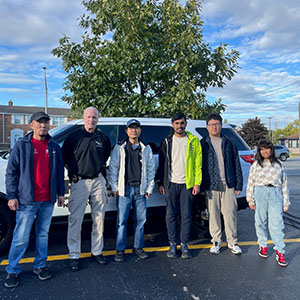PNW Computer Science research team tests AI-powered gunshot detection technology

A research team of PNW Computer Science faculty and students collaborated with PNW Police to test an artificial intelligence-powered gunshot detection technology apparatus. Pictured, from left, include Bayart Enkh, Computer Science master’s student; Brian Miller, director of Public Safety at PNW; Wei (David) Dai, assistant professor of Computer Science; Computer Science master’s students Sirish Chejerla and Rui Zhang; and Computer Science undergraduate student Diya Kafle.
As artificial intelligence (AI) continues to rapidly grow as a contemporary technology, faculty and students at Purdue University Northwest (PNW) are researching its practical uses to benefit humans in many different capacities.
Wei (David) Dai, assistant professor of Computer Science and director of the Advanced Intelligence Software Lab, has been interested in the practical application of AI with public safety initiatives since he began his own doctoral research. With the help of three student research assistants and collaboration with the PNW Police Department, the group developed and successfully tested a Gunshot Detection System apparatus powered by AI. The technology may pave the way for improving safety on school campuses and reducing response times to incidents involving gun violence.
“When our team was approached by Dr. Dai and his Computer Science research assistants regarding this project, we were excited to partner with them on the trials, as well as provide guidance during the research process,” said Brian Miller, director of Public Safety. “It is amazing to see PNW faculty and students’ innovation as they apply their research and design proposed solutions that could deliver positive change to many others beyond Northwest Indiana.”
Nearly instantaneous alerts
The Gunshot Detection System’s research purpose is ultimately intended to help reduce law enforcement officials’ response time because of the average delay in humans’ recognition of gunshots.
To help inform its research, the team analyzed 15 case studies involving active shooter scenarios at schools. The researchers found five minutes was the approximate time it took for someone to recognize gunshots from a potential active shooter and call 911.
When tested, the Gunshot Detection System recognized a gunshot and was able to alert PNW Police in two to five seconds.
“Every minute that can be saved in response time in turn means lives that can be saved,” said Brian Miller, director of Public Safety at PNW. “An average time of five minutes before a 911 call is way too long. With this technology, police officers can get the notification immediately as well as the audio.”
The research team began by training the AI program to recognize gunshot sounds at a firearms shooting range. The team also taught the program to identify other loud noises, such as a popping balloon or a firework, in order to differentiate the sounds. By understanding how to contrast these noises, the program can accurately identify true gunshots and relay data to first responders within seconds to alert them to a potential active shooter.
The research team furthermore trained the AI program to recognize the locations of gunshots inside large, multistory buildings. Partnering with the PNW Police, researchers tested blank ammunition for the AI to recognize. The program had nearly perfect accuracy on recognition of the first gunshot, followed by 100% accuracy in recognizing a second gunshot in each trial. The program also pinpointed which floor location the gunshots came from.
“If you are a police officer responding to an active shooter in a multi-level building, it can be difficult to identify the shooter’s location because of echoes and other sounds,” said Miller. “This device can tell us the direction and floor, such as the north side of the building and the second floor. That is a tremendous help to a response in identifying an active shooter.”
Practical uses
Historically, other commercial gunshot detection technologies have existed on the market. Police departments, for example, may contract with companies’ technology that can accurately pinpoint gunshots in different neighborhoods. However, these technologies can cost up to hundreds of thousands of dollars to cover a wide area, said Miller.
Dai estimates installation of the Gunshot Detection System technology would only cost up to $5,000 per module.
“I am incredibly proud of the research team’s work and PNW Police’s help in studying this technology’s effectiveness,” said Dai. “At PNW, many of our projects involve applied research that can demonstrate positive impacts and contribute to social good. Artificial intelligence allows us to investigate new possibilities that in turn can become tangible benefits for people.”